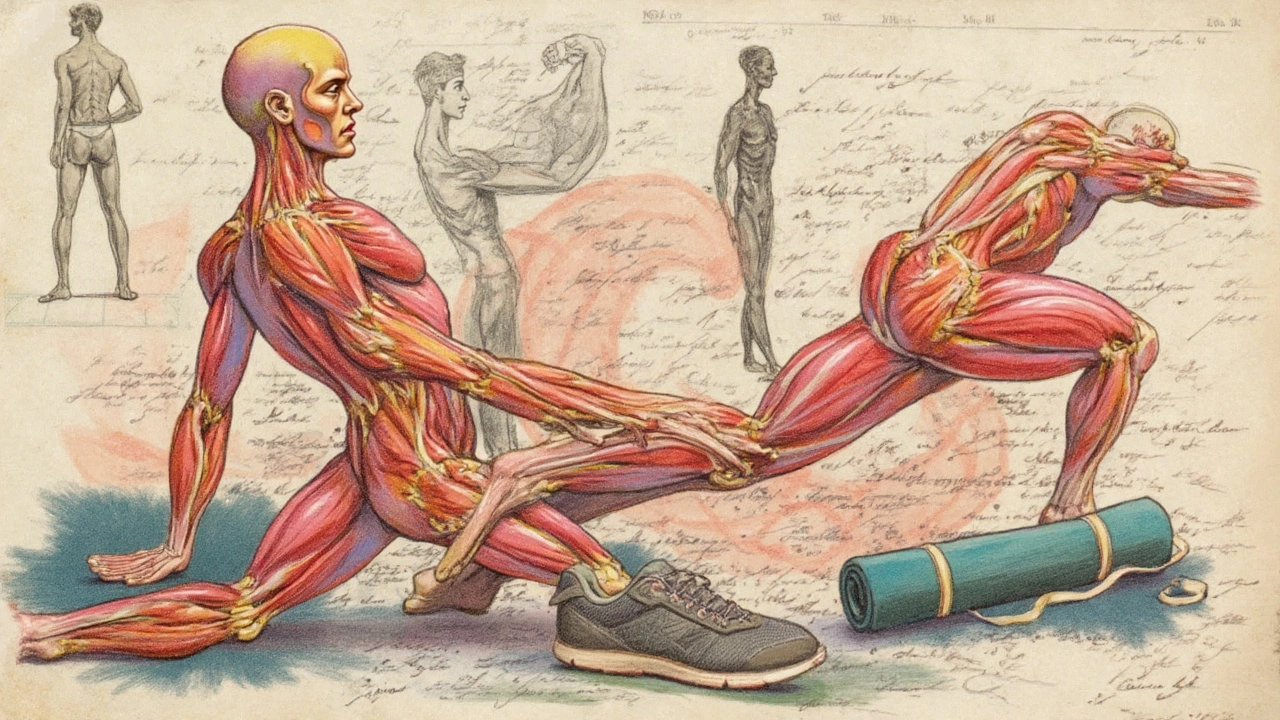The Truth About Fascia Stretching and Its Impact on Fitness
 Apr, 1 2025
Apr, 1 2025
You know, we always hear about stretching our muscles before and after a workout, but there’s another part of our body we often overlook: fascia. Fascia is like this connective tissue web keeping everything in place. Imagine it as that clingy film covering a piece of meat—yeah, it’s crucial for movement and flexibility.
Have you ever felt stiff even after religiously stretching? It might not be your muscles' fault—it could be your fascia needs some love. Stretching fascia can supercharge your flexibility and make your workouts more effective. How? By ensuring your muscles can move freely and correctly.
But still, there are so many misconceptions floating around, like fascia stretching is only for athletes or that it’s some kind of fad. Spoiler alert: it’s not just a buzzword—it has real, tangible benefits.
- What is Fascia and Why it Matters
- Benefits of Fascia Stretching
- Debunking Myths About Fascia
- How to Incorporate Fascia Stretching into Your Routine
- Real-life Tips and Techniques
What is Fascia and Why it Matters
So, let's talk about fascia. It’s like that surprise character in a movie—totally vital but often overlooked. Basically, fascia is a layer of connective tissue that surrounds and holds every organ, blood vessel, bone, nerve fiber, and muscle in place. Think of it as a spider web inside your body, keeping everything together.
You might wonder, why should I care about fascia? Well, when your fascia is tight or damaged, it can restrict movement and lead to pain. It becomes a big deal when you’re trying to get the most out of your fitness routine. Imagine trying to run with a stiff rubber band around your legs—not ideal, right?
Healthy fascia means your muscles can work more efficiently. It helps with flexibility, circulation, and even reduces post-workout soreness. This makes fascia stretching a game-changer, not just for athletes but for anyone looking to improve their movement and prevent injuries.
Interestingly, fascia isn’t static; it responds to movement and hydration. So, staying active and well-hydrated can keep this tissue in top shape. A fun fact: by the time you reach adulthood, you’ve got about 70,000 miles of fascia running through your body—nuts, right?
For fitness fans, incorporating fascia work into your routines can go a long way in enhancing your performance. It’s an often misunderstood area that, when given attention, can boost your overall exercise effectiveness. So, if you haven’t considered it before, now’s the time to give your fascia a little more credit in your fitness journey.
Benefits of Fascia Stretching
Let’s cut to the chase: fascia stretching can radically change your fitness game. One big perk is how it helps muscles recover. By allowing muscles to move smoothly within their surrounding fascia, recovery time goes down. So, if you’re big into workout sessions and often fight that sore aftermath, this could be your secret weapon.
But that’s just the start. Fascia stretching also boosts flexibility. Tight fascia can lead to those stubborn spots that just don't seem to loosen up no matter how hard you stretch. Addressing the fascia helps untangle these knots, giving you a wider range of motion. Ever reached for something and felt like your arm couldn't go further? Working on your fascia might free up that kind of restriction.
You also get an edge in injury prevention. When your fascia is healthy, it acts like a cushion, reducing strain. This is especially helpful if you’re prone to strains or just want to safeguard those hard-working muscles. Think of it as adding an extra layer of protection to your body’s framework.
As a bonus, many folks report feeling more in tune with their bodies. Fascia stretching calls for a slower, more focused approach compared to typical stretches. This mindfulness can actually enhance your body awareness, leading to better posture and overall balance.
- Enhanced muscle recovery due to reduced restrictions
- Increased flexibility allowing a greater range of motion
- Reduced risk of injuries through better support and cushioning
- Improved body awareness enhancing posture and balance
Lastly, there’s the performance factor. Athletes, or even weekend warriors, can benefit from the way fascia stretching helps in achieving optimal muscle function. Peak performance isn’t just about raw strength; it’s also about efficiency and control, which all tie back to healthy fascia.

Debunking Myths About Fascia
Alright, let's clear the air about fascia stretching. There’s a lot of internet chatter out there, and not all of it is on point. First up, some folks think fascia stretching is only for pro athletes or folks facing specific injuries. Well, surprise! It's actually for everyone. You don't need to be hitting the gym daily or running marathons to benefit. Your everyday desk warriors can gain just as much from incorporating it into their life.
Another myth floating around is that fascia stretching is a quick fix or a one-time solution. It's definitely not a magic bullet. Think of it like brushing your teeth. You don't just do it once and expect great dental hygiene, right? Regular, consistent practice is key here.
Some people worry that working on their fascia will be painful or dangerous. That's mostly Hollywood drama. Sure, some discomfort is normal as you’re working with tissue that might be tight or restricted, but it shouldn’t have you wincing in pain. If it does, ease up and listen to your body.
Then we've got the belief that fascia stretching is just another fitness fad. It's been a hot topic recently, but fascia is not new. This connective tissue has been around since humans have, and folks have been working with it long before it had a fancy name.
Finally, there's the idea that fascia doesn't really change. Interestingly enough, fascia can be ‘trained’ just like muscles. With regular stretching and movement, it can become more pliable and elastic. Check this out: some studies have suggested that regular fascia-focused stretching can improve your range of motion and performance. Now, who wouldn't want that?
How to Incorporate Fascia Stretching into Your Routine
Getting into fascia stretching doesn't have to be rocket science. It's all about adding a few new moves and maybe tweaking your usual drills a bit. So, how do we do it? Here are some practical steps to get you started:
First up, warm up your body. Before diving into any routine, you need to wake up those muscles and tissues. A light jog or some dynamic stretches could do the trick.
- Roll it out: Using a foam roller is a popular way to loosen tight fascia. Just roll over different muscle groups, like your thighs or back, to give them a deep tissue massage.
- Stretch it slow: Unlike muscle stretches, which might be quick, hold these ones longer. Think about holding each stretch for at least one to three minutes.
- Twist and turn: Adding some twists to your stretches can help target the fascia effectively. Consider yoga poses like the revolved triangle pose.
- Connect with breathing: Deep breathing while stretching can further release those tight spots, so try to focus on breaths that are deep and relaxing.
You might be wondering, 'How often should I do this?' Aim for fascia stretching a couple of times a week. It’s all about what feels right and doesn’t overdo it. Listen to how your body responds.
If you’re a data geek (like some of us), keep tabs on your progress with a simple table:
| Week | Flexibility Gains |
|---|---|
| Week 1 | Minimal improvement |
| Week 2 | Slightly better range |
| Week 3 | Noticeably easier movement |
| Week 4 | Significant flexibility boost |
Remember, just like any other health practice, consistency is key. Stick with it, and those gains won't just be a dream. Give fascia stretching a shot—it might be the game-changer your fitness routine needs.

Real-life Tips and Techniques
Alright, let’s get down to the nitty-gritty of fascia stretching. If you're new to this, no worries. Adding it to your fitness routine is simpler than you might think. Here’s how you can do it without feeling like you need a degree in kinesiology.
First off, hydrate like it’s your job. Why? Because fascia is super responsive to water. Imagine trying to stretch a dry sponge versus a wet one. See the difference? More water means more flexibility in your fascia. So, keep that water bottle handy.
To start with fascia stretching, you don't need fancy equipment. A foam roller can be your best friend. Rolling not only loosens tight spots but also boosts blood flow, which is fantastic for recovery.
- Foam Rolling: Focus on areas like your back, thighs, and calves. Apply gentle pressure and roll slowly. If you hit a tender spot, pause for about 30 seconds. Your body will tell you when it’s enough.
- Static Stretching: These are the stretches you’re probably familiar with. Hold static stretches at the end of your routine. The key is gentle and slow—no need to punish your body.
- Dynamic Stretching: This is great for pre-workouts. Try movements that mimic actions in your workout. It not only warms you up but gets the fascia ready for what’s to come.
A little fact to chew on: According to some fitness pros, dedicating just 10 minutes a few times a week to fascia stretching can seriously up your fitness game. It's not a huge time commitment, but the payoffs are massive.
| Activity | Duration | Frequency |
|---|---|---|
| Foam Rolling | 5-10 minutes | 3-4 times a week |
| Static Stretching | 10-15 seconds per stretch | Post workout |
| Dynamic Stretching | 5 minutes | Pre-workout |
And remember, the goal is consistency. Like anything in fitness, persistence beats perfection. Listen to your body and let fascia stretching gradually make your workouts safer and more effective.
